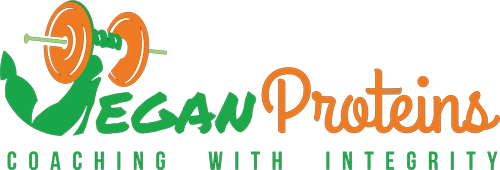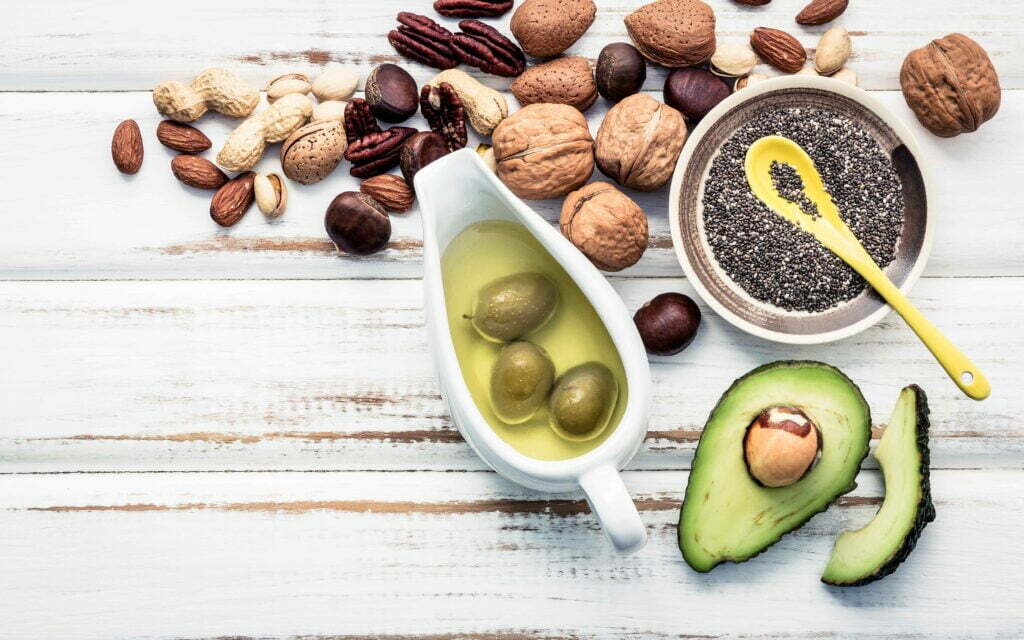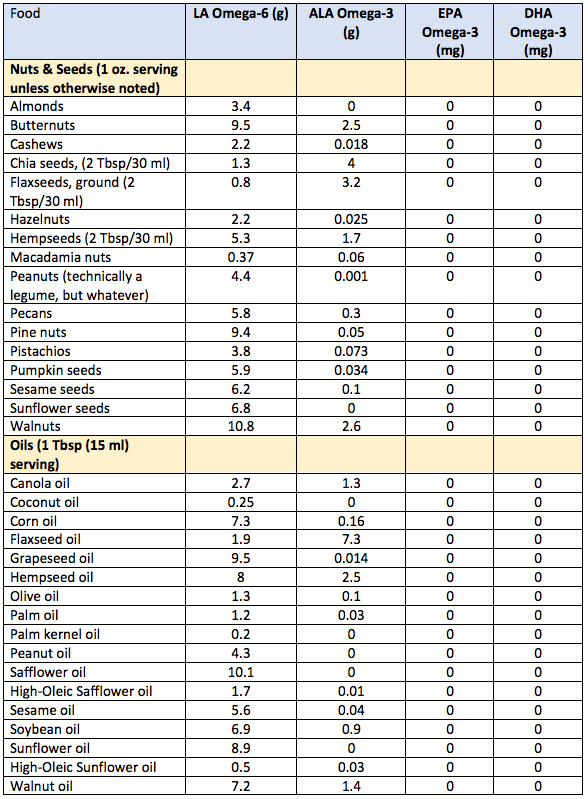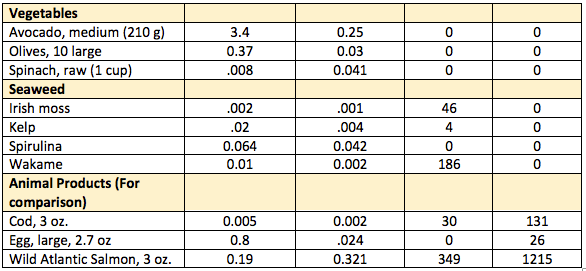Vegans and Essential Fatty Acids
By Natalie Pape, MA RDN
The news has been abuzz in the plant-based world recently about a certain high-profile celebrity tossing in the vegan towel for a pescatarian diet, due to her concerns over brain function. What she is referring to is the omega-3 fats prevalent in fish and the relationship of these essential fatty acids, specifically EPA and DHA, to nervous system health. Putting whatever feelings or indifference you may have about the lives of popstars aside, is there something to her decision to add fish to her diet? Should vegans be concerned about their omega-3 intake? As most answers in the nutrition world go, it depends.
First, what even are fatty acids?
*If you are interested in recommendations and a bottom-line answer, skip to the end*
What Are Fatty Acids?:
Just as a glucose molecule is to carbohydrates, and an amino acid is to proteins, a fatty acid is the basic component of fats. The fat in food contains three types of fatty acids in varying degrees: Saturated, monounsaturated, and polyunsaturated, all of which refer to the amount of hydrogen present on the carbon chain that makes up their chemical structure. The more hydrogen on the chain, the more “saturated” the molecule is, and the more solid a structure. In saturated fats, the carbon chain is completely packed, or saturated, with hydrogen. In monounsaturated fats, one spot in the carbon chain isn’t bound to hydrogen (mono = one), and in polyunsaturated fats, two or more spots on the carbon chain aren’t bound to hydrogen (poly = many). So polyunsaturated fats have the least amount of saturation. The amount of saturation in fats is important as it determines the form and therefore the function of the fat molecule.
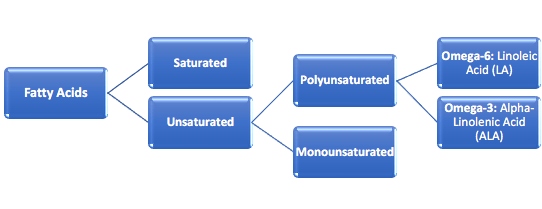
Trans-fats are another type of fatty acid you may get from food. They are industrialized hydrogenated fats, formed by artificially adding in hydrogens to mimic saturated fats (some do exist naturally in small amounts in meat and dairy). These types of fats only need a mention to acknowledge their existence. Then like a good friend concerned about your toxic romantic relationship, I’ll tell you to avoid them whenever possible since they actually compete against essential fatty acids for integration into cells. This is something to note since we are talking about ensuring a healthy essential fatty acid status here. Not to mention, trans-fats raise cholesterol, trigger inflammation, and increase insulin resistance. See? Toxic relationship. You deserve so much better than that.
The Importance of PUFAs:
Do you know how a tub of coconut oil is solid until you heat it up? That’s because it is high in saturated fat, where the chemical structure is sturdier. Fats high in polyunsaturated fatty acids (PUFAs), however, are liquid even when you refrigerate them. Because PUFAs are missing many hydrogens, it causes their chain to have a “kink” or bend which allows them to remain fluid in structure. People associate fish with omega-3s, a type of PUFA because cold-water fish have higher concentrations of these fats in their cell membranes. This gives them the fluidity to move through cold temperatures. A fish in cold water could not get very far if its cells hardened up like a tub of coconut oil (fats, like coconut and palm kernel oil, from warmer climates, tend to be more saturated). This explains the role polyunsaturated fats play in our bodies. In this way, PUFAs are important in keeping our cells’ membranes more fluid and increasing cell signaling. It makes sense that our nervous systems would need to be made of these kinds of polyunsaturated fats to work properly. When brain cell membranes are relatively fluid, messages from neurochemicals can be transmitted more easily. So, when it comes to the PUFAs that make up these important systems, it’s good to be kinky.
Essential Fatty Acids and The Big Deal About EPA/DHA:
There are two types of fats, both of which fall under the polyunsaturated fatty acid (PUFA) category, which are essential. This means we cannot make them on our own and we must get them from our diets. Think of these two types of essential fatty acids (EFA) as two families each with a “parent” at the head of the household: linoleic acid (LA) is the parent of the omega-6 family, and alpha-linolenic acid (ALA) is the parent of the omega-3 family. From these two-parent branches, our bodies can construct another polyunsaturated fatty acid “children” with longer chains called highly unsaturated fatty acids (HUFAs).
While the omega-6 parent, LA, converts easily into its HUFA children gamma-linolenic acid (GLA), dihommogamma-linolenic acid (DGLA), and arachidonic acid (AA), the omega-3 parent, ALA, has a hard time converting into its HUFA children eicosapentaenoic acid (EPA) and docosahexaenoic acid (DHA), two extremely important long-chain fatty acids. Omega-3s, and DHA especially, are crucial in providing the building materials for the brain, nervous system, eyes, and cell membranes. They also aid intracellular signaling and gene expression and produce biologically active hormone-like compounds called eicosanoids, protectins, and resolvins.
As you can see from the chart below, these compounds formed within each family tree (as shown in the green and the red bubbles) have almost opposite effects. The ones formed from EPA and DHA in the omega-3 family tree tend to have overall anti-inflammatory effects: They reduce the stickiness of blood, improve blood flow, decrease cell division, and enhance immune function. The protectins and resolvins derived from EPA and especially DHA, as their name implies, both protect against and resolve inflammation. This seems to be why people make such a big deal of them, plus there is strong evidence omega-3s play a key role in disease prevention. In contrast, the compounds formed from the omega-6 derivative arachidonic acid (AA) tend to have a pro-inflammatory effect: They increase the stickiness of blood, decrease blood flow, increase cell division, and suppress immune function.
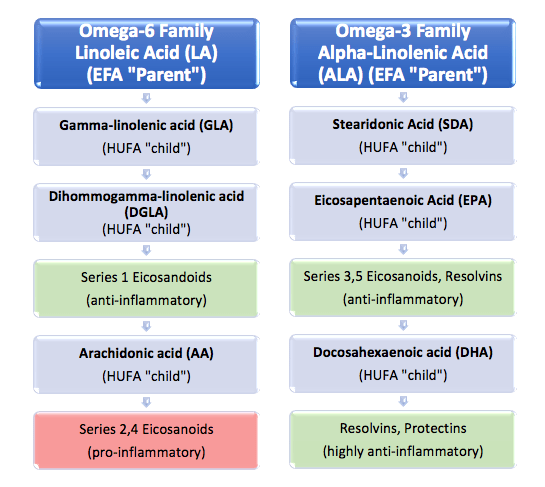
Now just because the compounds formed from the omega-6 family tend to be more pro-inflammatory, that does not mean they are “bad”- Don’t let that red bubble in the chart fool you. We need the eicosanoids from both families of fats, even the pro-inflammatory ones. If we didn’t have enough of them, we wouldn’t be able to clot our blood to stop bleeding or recover from a hard training session. Like in any properly functioning family unit, the key here is balance. If the omega-6s are like the strict parent there to make sure the kids get their homework done, the omega-3s are like the fun parent keeping everything chill. Having either out of whack would cause serious problems. The point is, that this omega-6 to omega-3 balance is important, and especially so when a diet does not include direct sources of EPA and DHA.
So, our bodies can, potentially, convert the parents’ LA and ALA into all the omega-6 and omega-3 HUFA children we need. But if our bodies can make all these HUFAs, then why are ex-vegan popstars worried about eating fish for EPA and DHA without just relying on this conversion? The answer comes down to balance.
Conversion of ALA and Balancing the Omegas:
Remember when I said “it depends” whether vegans should worry about their omega-3s? It depends because there are varying factors that may affect each person’s essential fatty acid status, and ALA’s rate of conversion has a big, unpredictable range. The conversion of ALA to EPA can range from about 0.3 percent to as much as 21 percent, while the rate of conversion to DHA ranges from 0 to about 9 percent. It varies among individuals and at different stages of life.
What affects this conversion rate? Diet is a big factor. As mentioned earlier, trans-fatty acids can inhibit conversion, as can excessive intake of alcohol and caffeine. Not to mention, excesses of all three of these can have impacts on inflammation, sleep, and muscle gain which is especially something we need to be mindful of as vegans working toward physique goals. Nutritional inadequacies, such as protein deficiency (not actually an issue for vegans consuming adequate calories and especially not an issue for any vegan athlete tracking sufficient protein intakes for body composition goals), or deficiencies in certain vitamins and minerals like zinc, magnesium, niacin, pyridoxine, and vitamin C, can all reduce the activity of conversion enzymes.
However, the most impactful dietary factor negatively affecting ALA conversion rates to EPA and DHA is a high intake of omega-6 fatty acids. This can reduce conversion rates by as much as 40 to 60 percent! When it comes to the conversion of the parent omega-3 ALA to its HUFA child DHA, all the way at the end of the omega-3 family tree, things can get tricky. For our bodies to make EPA and DHA, the ALA parent undergoes a process of reactions where its chain elongates and desaturates (the chain becomes longer, and it becomes less saturated with hydrogen) all with the help of enzymes. Enzymes are like the catalyst for basically every chemical reaction in the body and if not for them, metabolic reactions would take too long to happen, or not happen at all. The two essential fatty acid families compete for the same enzymes. So, if you are getting too many omega-6 fatty acids, it can reduce the conversion in the omega-3 family or vice versa.
Until a couple of centuries ago, most diets provided an omega-6 to omega-3 fatty acid ratio of about 2:1 or even 1:1. At this more balanced ratio, conversion from the parent EFAs to longer-chain HUFAs would be significantly higher. This makes sense because if the body could not convert ALA to EPA and DHA, humans would not be able to survive without fish, sea vegetables, or microalgae (the primary source from where fish get their EPA and DHA- I’m lookin’ at you, previously mentioned popstar). Centuries ago, those peoples living inland would never have access to such foods. Our bodies have a pretty good way of adapting to the conditions we put them in: Not consuming direct sources of DHA can enhance the rate of conversion from ALA to DHA. And if we do consume direct sources of DHA, it depresses the final step in conversion from EPA to DHA by 70 percent or more. In other words, if we eat DHA directly, our bodies do not need to go through the full conversion process at maximum capacity since it is already getting the DHA it needs; if we don’t eat DHA, our bodies try to do their best to enhance the conversion.
Fast forward to modern times, where big changes in the food supply have thrown off the 1:1 omega-6 to omega-3 ratio to an average of 10:1 and higher! In vegan diets specifically, this balance can be even more out of proportion, ranging from 8:1 to 20:1. Likely, this is due to an increased intake of foods higher in LA omega-6s (nuts, seeds, and especially vegetable oils), and since there are fewer plant sources high in ALA compared to LA. This imbalanced ratio can adversely affect our ability to recover from workouts and can promote inflammation and chronic disease progression. While ALA intakes of vegans are similar to those of omnivores, dietary intakes and blood and tissue levels of EPA and DHA can be significantly lower in vegans, since there are fewer vegan food sources available (we’ll discuss dietary sources in the next section). However, the clinical relevance of reduced EPA and DHA status among vegetarians and vegans is still unknown; despite this, vegans still have a lower rate of heart disease and a lower overall mortality rate.
There are plenty of factors outside of our control that may limit our ability to convert ALA to DHA. Other than diet, the biggest factors come down to our genes, changes throughout the lifespan, and our biological sex. Conversion enzymes can slow or limit the rate of conversion of ALA to DHA in some people because of variants in key genes. Some people may synthesize more of the omega-6 polyunsaturated fatty acid arachidonic acid (AA) which leads to high production of the pro-inflammatory eicosanoids. This means that people with these genes can have a higher rate of chronic diseases, like heart disease, especially if they have a higher omega-6 to omega-3 ratio in their diet. Other factors that slow conversion are smoking and advancing age (both of which depress enzymes), and chronic diseases like diabetes, metabolic syndrome, hypertension, and hyperlipidemia (elevated blood lipids).
Although fasting may reduce ALA conversion, low-fat diets (with 20 percent of calories from fat vs. higher fat diets with 45 percent of calories from fat) or calorie-restricted diets appear to enhance conversion. That may be some good news for anyone currently in competition prep or in a larger calorie deficit.
Those with a female reproductive system may have some advantage in their ALA to DHA conversion rates during childbearing years where the rate is at the upper end of the conversion range. This may be because the hormone estrogen boosts DHA synthesis during this stage of life. This makes sense since it may be the body’s way of ensuring a potential mother would have more of the DHA needed to grow a baby’s brain.
What foods have Omega-6s and Omega-3s?
Plant foods high in omega-6 fatty acids include cooking oils like sunflower, safflower, soybean, corn, grapeseed, or sesame oil, as well as many processed foods, such as dressings, margarine, crackers, cookies, and high-fat foods that rely on these omega-6-rich oils. Balanced oils will still have omega-6 linoleic acid (LA) but will also include enough omega-3 alpha-linolenic fatty acids (ALA) to have a 1:1 or 2:1 ratio of omega-6 to 3. For example, 1 tablespoon of an omega-6-rich oil, like corn oil, has over 7 grams of LA and only 0.16 grams of ALA. Compare that to a balanced oil, like canola, with 1 tablespoon having 2.7 grams of LA and 1.3 grams of ALA, for an ideal ratio of 2:1.
Avocados, olives, and most nuts are concentrated sources of monounsaturated fatty acids, although they also contain some saturated fatty acids and LA as well, so they still contribute to omega-6 intakes. Per ounce, most nuts contain 1 to 3 grams of omega-6 fatty acids (other than pecans, pine nuts, and butternuts), and a medium avocado provides over 3 grams of LA. Eating large portions of seeds or nuts that have more omega-6 to omega-3 fatty acids, like sunflower seeds, pumpkin seeds, sesame seeds, and pine nuts, could also push omega-6 intake over. Including some concentrated omega-3 sources when consuming these foods can help to bring omega-6s into balance.
It is difficult to consume ALA without also increasing the amount of LA at the same time, unless specific foods concentrated in ALA are eaten, like flaxseed/oil (make sure to grind whole flaxseeds or buy pre-ground flax meal) or chia seeds. In addition to flax and chia, foods with a healthy balance of omega-6 to omega-3 fatty acids include hemp seeds/oil, walnuts, and leafy greens. While leafy greens do have a nice balance of omega-6 to omega-3 and actually provide more omega-3s than 6s, their overall fat content is so low that you’d have to eat over 10 raw cups to provide just 1 gram of ALA! Other vegetables, grains, legumes, and fruits are also all very low in fat, so they make minor contributions to fatty acid intake. One exception is tofu, with more than 40 percent of its calories from fat, which provides 0.4 grams of ALA per 100-gram serving. Grains have more omega-6s than omega-3s with a varying average ratio. The fat in legumes and fruits are both mainly polyunsaturated with an average omega-6 to omega-3 ratio of about 1:1 for legumes (except for chickpeas and lentils which have higher omega-6s) and between 1:1 and 2:1 for fruits, putting them in the ideal window of omega fatty acid balance.
Direct sources of EPA and DHA fatty acids are typically found in animal foods: Chickens are supplemented with omega-3-rich feed to produce eggs higher in DHA, farmed fish or livestock are likewise fed omega-3 supplements, or wild fish feed on food sources high in ALA, EPA and/or DHA like sea vegetables and microalgae. Although fish are indeed a rich source of EPA and DHA, they are also a highly concentrated source of contaminants like heavy metals, industrial pollutants, and microplastics. Luckily, vegans can skip the fishy middleman and the carcinogens by getting EPA and DHA directly from cultured microalgae supplements. Unlike fish, cultured microalgae are free of contaminants since they are manufactured and are not harvested directly from polluted waters. Considering the rapid decline in fish species, finding alternative sources of long-chain omega-3 fatty acids makes good ecological sense.
Something to note: Even though it is rare because it would be a challenge to not get enough omega-6 linoleic acid (LA) with a plant-based diet, it is possible for vegans to overdo it with omega-3 fatty acids and cause an omega-6 deficiency. If vegans are eating a very low-fat diet by avoiding nuts, seeds, avocados, and other high-fat plant foods but also eating large amounts of foods high in omega-3s like flaxseeds, flaxseed oil, or chia seeds, this can throw off the omega-6 to omega-3 balance to result in a ratio of 1:2 or more, the reverse of what is considered the goal. This would reduce the conversion of the omega-6 parent LA to HUFA child AA, leading to dry hair, skin, and eyes, joint pain, brittle nails, and increased chronic disease risk.
Sources of Omega-6 and Omega-3 PUFAs:
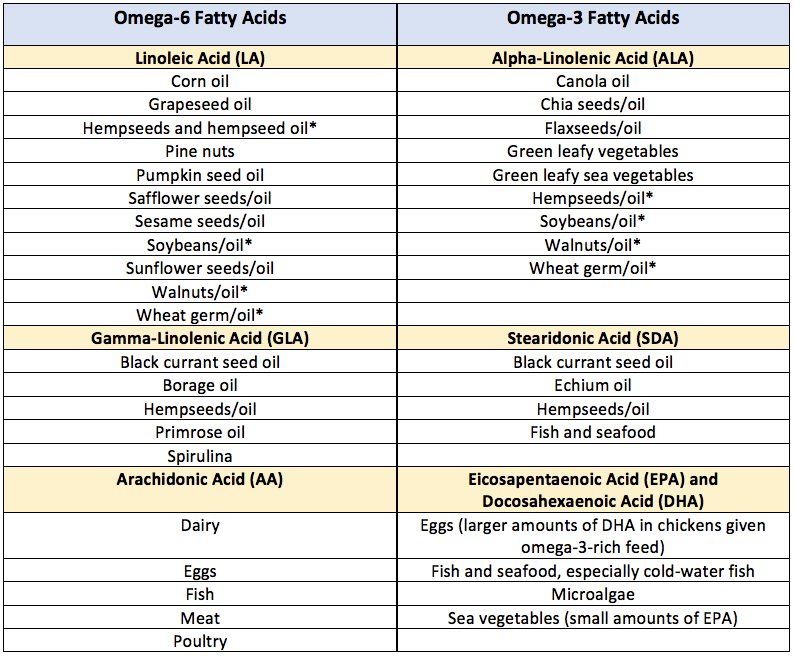 *Significant sources of both LA and ALA
*Significant sources of both LA and ALA
Composition of Omega-6 and Omega-3 in Plant Foods:
The Bottom Line:
The two essential fatty acids are linoleic acid (LA), the parent of the omega-6 family, and alpha-linolenic acid (ALA), the parent of the omega-3 family. The essential fatty acids can be converted into larger, long-chain fatty acids: LA to gamma-linolenic acid (GLA) and arachidonic acid (AA), and ALA to eicosapentaenoic acid (EPA) and docosahexaenoic acid (DHA). These long-chain fatty acids are used to produce hormone-like compounds that have a significant benefit on many body functions. Both EPA and DHA are necessary for brain, eye, nervous system function, and play an important role in reducing chronic inflammation.
Increasing ALA intake relative to LA intake can be an effective strategy for boosting conversion to EPA and DHA in healthy people, but the body’s capacity for the conversion is limited, and genetic variations in metabolism can compromise conversion in some people. While vegans tend to produce plenty of long-chain omega-6 fatty acids, omega-3 conversion can be unpredictable and insufficient. A supplement that can help you boost your ALA intake, if that is something you’re interested in, Clean Machine’s Ahi Flower Oil is a great choice.
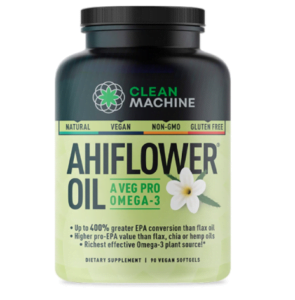
Taking a vegan DHA/EPA supplement is a personal choice, and there still needs to be more research on the long-term benefits of them. However, since conversion from ALA to EPA and DHA can be inadequate, there may be significant value to taking vegan microalgae supplements as an extra safety measure. Microalgae supplements are widely available and are an environmentally sustainable source of long-chain omega-3 fatty acids. Vegan Proteins recommends the Testa Vegan Omega 3 supplement pictured below.
So to put the original question to rest of whether vegans should consider adding fish to their diets: There is no need to add in fish to obtain the health benefits of long-chain omega-3s. Avoid the fish and the pollutants and go directly to the source with microalgae. Everyone’s food choices are theirs to make, but a well-planned vegan diet can provide all the nutrition you need, including long-chain omega-3s, for maintaining that big, beautiful brain of yours. Someone should go notify that pop star.
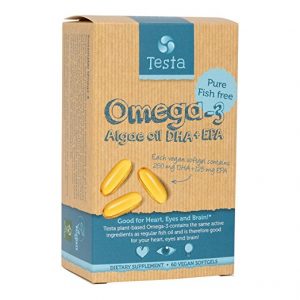 For Vegans to Optimize Their Essential Fatty Acid Status:
For Vegans to Optimize Their Essential Fatty Acid Status:
- Dietary ratios ranging from 2:1 to 4:1 of omega-6 to omega-3 seem a reasonable target to aim for. This ratio is especially important for vegans who rely solely on the conversion of ALA to meet their needs for EPA and DHA. Without supplementing with DHA/EPA, vegans need to up their daily ALA intake. When relying almost exclusively on ALA for omega-3 fatty acids, vegans should base the intake amount on double the current AI: Men should consume 3.2 grams of ALA per day, while women should obtain 2.2 grams per day.
- If you decide to supplement with a direct source of DHA, you do not need to increase ALA over the current AI recommendation which is 6 grams of ALA for men and 1.1 grams for women. For most people, a supplement of 100 to 300 mg per day of DHA is adequate.
- Those who are pregnant, nursing, highly active, or have a metabolic disorder that limits the ability to produce conversion enzymes, should especially consider taking a DHA/EPA supplement. Omega-3s may be especially important for regulating the inflammatory process during more strenuous activity, so it may make sense for vegan athletes to make sure they are getting somewhat higher intakes of omega-3s while watching their intake of LA.
- Eat sufficient protein, vitamins, and minerals to maximize conversion of ALA to long-chain highly unsaturated fatty acids.
- Avoid trans-fatty acids and excess consumption of alcohol or caffeine as these can reduce conversion.
- Reduce your intake of omega-6 fatty acids, if excessive. Focus on foods that are good sources of monounsaturated fat like olives, olive oil, nuts, and avocados, and more concentrated sources of ALA omega-3 fats like ground flaxseed, chia seeds, hemp seeds, canola, and walnuts and their oils while limiting foods high in LA omega-6 like corn, safflower, soybean, and sunflower oils along with vegetable shortening, most margarine, and more processed foods that use these oils.
Sources:
- Melina V, Craig W, Levin S. Position of the Academy of Nutrition and Dietetics: vegetarian diets. J Acad Nutr Diet. 2016; 116(12):1970-1980.
- Davis B, Melina V. Becoming Vegan: Comprehensive Edition. Summertown, TN: Book Publishing Co; 2014: 117-134.
- Burns-Whitmore, B., Froyen, E., Heskey, C., Parker, T., & San Pablo, G. (2019). Alpha-Linolenic and Linoleic Fatty Acids in the Vegan Diet: Do They Require Dietary Reference Intake/Adequate Intake Special Consideration?. Nutrients, 11(10), 2365.
- Bloomer RJ, Larson DE, Fisher-Wellman KH, Galpin AJ, Schilling BK. Effect of eicosapentaenoic and docosahexaenoic acid on resting and exercise-induced inflammatory and oxidative stress biomarkers: a randomized, placebo-controlled, cross-over study. Lipids Health Dis. 2009;8:36.
- Saunders AV, Davis BV, Garg ML. Omega-3 polyunsaturated fatty acids and vegetarian diets. Med J Aust. 2013;199(4 Suppl):S22-26
- Sarter B, Kelsey KS, Schwartz TA, et al. Blood docosahexaenoic acid and eicosapentaenoic acid in vegans: Associations with age and gender and effects of an algal-derived omega-3 fatty acid supplement. Clin Nutr. 2015;34(2):212-218.
- Da Boit M, Hunter AM, Gray SR. Fit with good fat? The role of n-3 polyunsaturated fatty acids on exercise performance. Metabolism. 2017;66:45-54.
